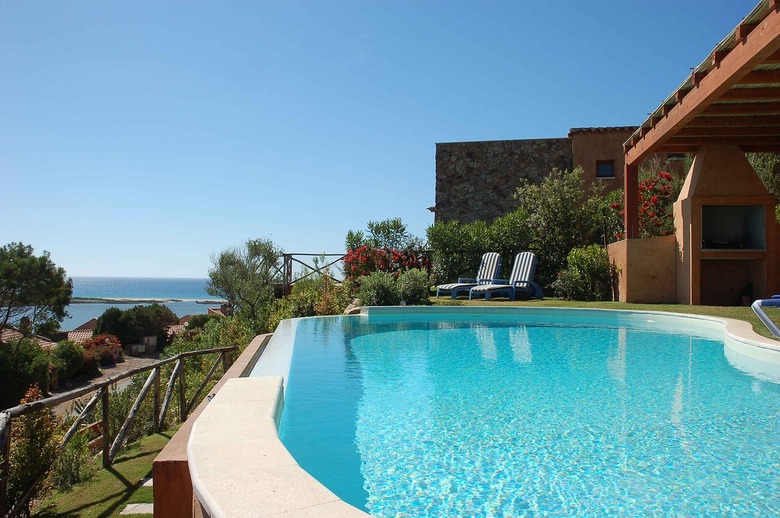How To Clean Above Ground Pools
To keep the water in your above-ground pool crystal clear, maintaining the chemicals is just as important as it is for an in-ground pool. A healthy supply of free chlorine in water with a slightly alkaline pH and proper amounts of stabilizer keeps bacteria and algae at bay and prevents the water from turning cloudy or green. An above-ground pool is a magnet for falling leaves and other debris, and it's crucial to vacuum these out of the pool frequently, or they will upset the delicate chemical balance of the water. If algae do discolor the pool liner, scrubbing the liner, shocking the water and adding an algaecide should clear things up.
Check the Chemicals Often
If the weather is clear, you don't necessarily have to check your pool on a daily basis, but you should check it at least three times a week. Test the pH–the most important chemical characteristic of the water–and add acid, baking soda or soda ash as needed to maintain it between 7.2 and 7.6. Total alkalinity is a measure of the water's ability to maintain a stable pH, and it should be between 80 and 120 parts per million. You can usually adjust this with the same chemicals you use to adjust the pH. If the weather is rainy, check the pH more often, because rain makes the water acidic, and that's bad for swimmers as well as the pool liner.
- To keep the water in your above-ground pool crystal clear, maintaining the chemicals is just as important as it is for an in-ground pool.
- An above-ground pool is a magnet for falling leaves and other debris, and it's crucial to vacuum these out of the pool frequently, or they will upset the delicate chemical balance of the water.
The free chlorine concentration should be between 1 and 3 ppm, and the most efficient way to maintain it in an above-ground pool is to use chlorine tablets. They contain a stabilizer–cyanuric acid (CYA)–that prevents the chlorine from being degraded by sunlight. Place these slow-release tablets in the skimmer or the chlorinator–never directly in the pool water. If you choose to use liquid chlorine, you should add the stabilizer separately, maintaining the CYA level in a range from 20 to 50 ppm.
Clean the Pool Filter
If you run the circulation pump for the recommended 8 to 12 hours a day, most of the water in the pool will pass through the filter. Eventually, the filter will clog, and a clogged filter can't do its job. It may impede circulation, which in turn can affect the chlorine level. Sand and DE filters should be backwashed whenever the pressure reading is 8 to 10 psi above normal. If your pool has a cartridge filter, remove it weekly, and wash it with a garden hose.
Brush and Vacuum
Eddies in the pool water create stagnant areas, and these are breeding grounds for bacteria and algae. To prevent these from growing into a problem, you should brush down the sides of the pool weekly, skim debris off the surface and follow this by vacuuming the pool. The vacuum will also remove organic debris that collects on the bottom of the pool and contributes to water acidity.
Vacuuming isn't a job to be done when you're in a hurry. It's essential to move the vacuum slowly to prevent it from churning the debris into the water, where you can't get it. Vacuum too quickly, and you'll just have to vacuum again. If you don't have a pool vacuum, you should get one–but until you do, you can vacuum your above-ground pool with a shop vac.
Clearing Cloudy Water
When pool water turns cloudy, it's usually because the pH is too high. This reduces the amount of free available chlorine. Cloudiness is often accompanied by a chlorine odor, which indicates an excess of chlorine compounds, called chloramines.
- Eddies in the pool water create stagnant areas, and these are breeding grounds for bacteria and algae.
- Cloudiness is often accompanied by a chlorine odor, which indicates an excess of chlorine compounds, called chloramines.
The first thing you need to do is lower the pH, using muriatic acid or sodium bisulfate (dry acid). When the pH is where it should be, and you have added liquid chlorine or chlorine tablets, the cloudiness may dissipate. If not, you'll probably need to shock the pool by raising the pH to 10 ppm or more. If the water remains cloudy after the chlorine levels fall to 5 ppm, use a clarifier to amalgamate the sediment into particles large enough for the filter to remove. In severe cases, add a flocculant to the water to force the sediment to fall to the bottom, where you can then vacuum it out of the pool.
Dealing with Algae
Algae can cause the pool water to turn strange colors, such as green or yellow, and these colors become accentuated when the algae grows on the liner. You often have to double-shock the pool by using twice the normal amount of shock to kill the algae, but before you do this, scrub down the sides and bottom of the pool to suspend the algae in the water. After shocking, wait for the chlorine level to fall to 5 ppm, then introduce an algaecide to provide the coup de grace and prevent the algae from growing again.
